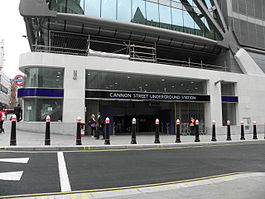Cannon Street station
| Cannon Street |
|
|---|---|
| London Cannon Street | |

Main entrance
|
|
|
Location of Cannon Street in Central London
|
|
| Location | Cannon Street |
| Local authority | City of London |
| Grid reference | TQ326808 |
| Managed by | Network Rail |
| Station code | CST |
| DfT category | A |
| Number of platforms | 7 |
| Accessible | Yes |
| Fare zone | 1 |
| OSI |
Bank |
| National Rail annual entry and exit | |
| 2011–12 |
|
| – interchange | 0.440 million |
| 2012–13 |
|
| – interchange |
|
| 2013–14 |
|
| – interchange |
|
| 2014–15 |
|
| 2015–16 |
|
| – interchange |
|
| Railway companies | |
| Original company | South Eastern Railway |
| Pre-grouping | South Eastern and Chatham Railway |
| Post-grouping | Southern Railway |
| Key dates | |
| 1 September 1866 | Opened |
| 5 June 1926 | Closed |
| 28 June 1926 | Reopened |
| 5 August 1974 | Closed |
| 9 September 1974 | Reopened |
| Other information | |
| Lists of stations | |
| External links | |
| WGS84 | 51°30′37″N 0°05′27″W / 51.5104°N 0.0907°WCoordinates: 51°30′37″N 0°05′27″W / 51.5104°N 0.0907°W |
|
|
|
| Cannon Street |
|
|---|---|

Entrance from Dowgate Hill
|
|
| Location | Cannon Street |
| Local authority | City of London |
| Managed by | London Underground |
| Station code | CST |
| Number of platforms | 2 |
| Accessible | Yes (Westbound only) |
| Fare zone | 1 |
| London Underground annual entry and exit | |
| 2012 |
|
| 2013 |
|
| 2014 |
|
| 2015 |
|
| Key dates | |
| 1884 | Opened (MICCR) |
| Other information | |
| Lists of stations | |
| External links | |
|
|
|
Cannon Street, also known as London Cannon Street, is a central London railway terminus and connected London Underground station located on Cannon Street in the City of London. It was built on the site of the medieval Steelyard, the trading base in England of the Hanseatic League, and it opened in 1866.
It is situated within fare zone 1 and is one of 19 stations in the United Kingdom managed by Network Rail. Main line train services out of Cannon Street are operated by Southeastern, serving destinations in southeast London and Kent; the Underground station is on the Circle and District lines between Monument and Mansion House.
Cannon Street is a terminal station approached across the River Thames by the Cannon Street Railway Bridge. Its approach by rail is by a triangular connection to both London Bridge and Charing Cross. There were originally eight platforms; a refurbishment in the late 1990s removed the original platform 1. It has entrances on Cannon Street itself and Dowgate Hill. It is also located near the London Stone (north from station), which was once used as the place from which all distances in Roman Britain were measured.
Opened by the South Eastern Railway on 1 September 1866, the original station building was designed by Sir John Hawkshaw and J. W. Barry and was characterised by its two Wren-style towers, 23 ft (7.0 m) square and 135 ft (41 m) high, which faced on to the River Thames. The towers supported a 700 ft (210 m) long iron train shed crowned by a high single arch, almost semicircular, of glass and iron. To this was joined in 1867 an Italianate style hotel and forecourt designed by E. M. Barry which provided much of the station's passenger facilities as well as an impressive architectural frontispiece to the street. This arrangement was very similar to that put in place at Charing Cross. The station is carried over Upper Thames Street on a 700 ft (210 m) long brick viaduct containing 27 million bricks. Below this viaduct there are remains of a number of Roman buildings, which form a scheduled ancient monument. Barry's five-storey City Terminus Hotel underwent two changes of name: first to Cannon Street Hotel in 1879, and later, as an office block, to Southern House.
...
Wikipedia

